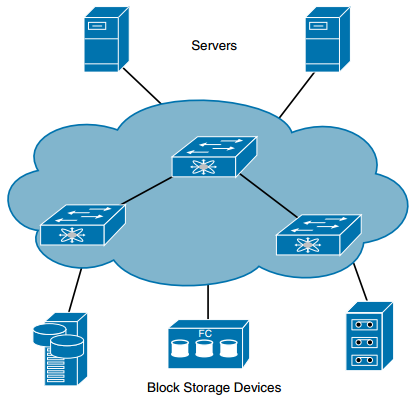CCNA DC FAQ: Introduction to Storage and Storage Networking
Q1. Which of the following options describe advantages of block-level storage systems? (Choose all the correct answers.)
a. Block-level storage systems are very popular with storage area networks.
b. They can support external boot of the systems connected to them.
c. Block-level storage systems are generally inexpensive when compared to file-level storage systems.
d. Each block or storage volume can be treated as an independent disk drive and is controlled by an external server OS.
e. Block-level storage systems are well suited for bulk file storage.
Answer: A, B, and D. Advantages of block-level storage systems are the following:
- Block-level storage systems offer better performance and speed than file-level storage systems.
- Each block/storage volume can be treated as an independent disk drive and is controlled by the external server OS.
- Each block/storage volume can be formatted with the file system required by the application (NFS/NTFS/SMB).
- Block-level storage systems are very popular with storage-area networks (SANs).
- Block-level storage systems are more reliable, and their transport systems are very efficient.
- Block-level storage can be used to store files and also provide the storage required for special applications such as databases, Virtual Machine File Systems (VMFS), and so on.
- Block-level storage systems can support external boot of the systems connected to them.
Q2. Which of the following options describe advantages of storage-area network (SAN)? (Choose all the correct answers.)
a. Consolidation
b. Storage virtualization
c. Business continuity
d. Secure access to all hosts
e. None
Q3. Which of the following protocols are file based? (Choose all the correct answers.)
a. CIFS
b. Fibre Channel
c. SCSI
d. NFS
Q4. Which options describe the characteristics of Tier 1 storage? (Choose all the correct answers.)
a. Integrated large scale disk array.
b. Centralized controller and cache system.
c. It is used for mission-critical applications.
d. Backup storage product.
Q5. Which of the following options should be taken into consideration during SAN design? (Choose all the correct answers.)
a. Port density and topology requirements
b. Device performance and oversubscription ratios
c. Traffic management
d. Low latency
Answer: A, B, and C. Following are the key principals of the SAN design:
- Port density and topology requirements: Number of ports required now and in the future
- Device performance and oversubscription ratios: Determination of what is acceptable and what is unavoidable
- Traffic management: Preferential routing or resource allocation
- Fault isolation: Consolidation while maintaining isolation
- Control plane scalability: Reduced routing complexity
Q6. Which of the following options are correct for Fibre Channel addressing? (Choose all the correct answers.)
a. A dual-ported HBA has three WWNs: one nWWN, and one pWWN for each port.
b. Every HBA, array controller, switch, gateway, and Fibre Channel disk drive has a single unique nWWN.
c. The domain ID is an 8-bit field, and only 239 domains are available to the fabric.
d. The arbitrated loop physical address (AL-PA) is a 16-bit address.
Q7. Which process allows an N Port to exchange information about ULP support with its target N Port to ensure that the initiator and target process can communicate?
a. FLOGI
b. PLOGI
c. PRLI
d. PRLO
Q8. Which type of port is used to create an ISL on a Fibre Channel SAN?
a. E
b. F
c. TN
d. NP
Q9. Which of the following options are correct for VSANs? (Choose all the correct answers)
a. An HBA or a storage device can belong to only a single VSAN—the VSAN associated with the Fx port.
b. An HBA or storage device can belong to multiple VSANs.
c. Membership is typically defined using the VSAN ID to Fx ports.
d. On a Cisco MDS switch, one can define 4096 VSANs.
Q10. Which of the following options are correct for iSCSI?
a. Uses TCP port 3225
b. Uses TCP port 3260
c. Uses UDP port 3225
d. Uses UDP port 3260
e. Uses both UDP and TCP
